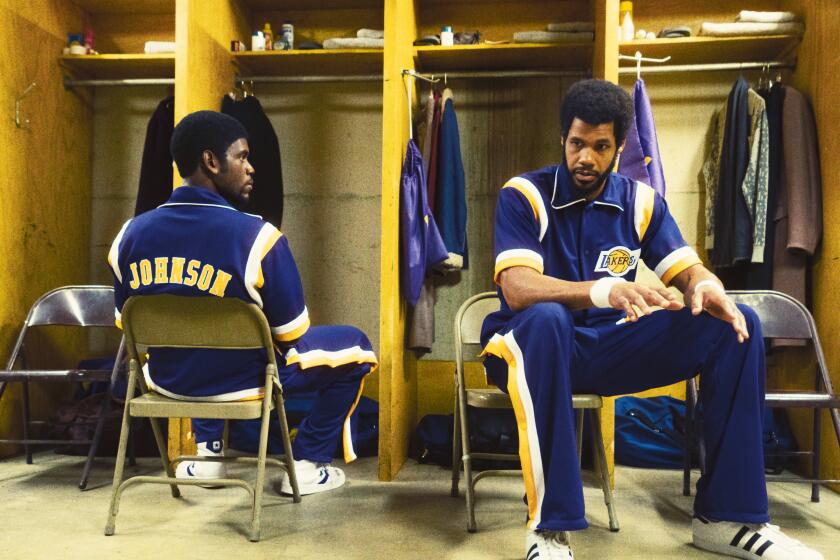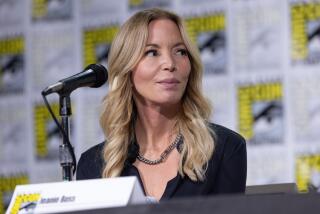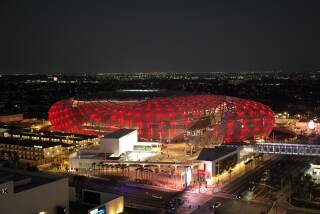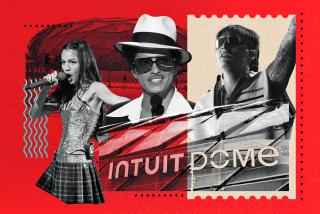- Share via
The Laker Girls. The Forum Club. Celebrities sitting courtside. The beating heart of Showtime-era Los Angeles was the “Fabulous Forum.”
In Episode 6 of “Binge Sesh,” hosts Matt Brennan and Kareem Maddox dive into the history of the Lakers’ longtime home. We look back on the Forum’s construction in the 1960s, its heyday under Lakers owner Jerry Buss and Forum general manager Claire Rothman, and the team’s move to the Staples Center to understand how a sports arena became the perfect symbol of 20th century L.A.
Listen now
Catch up on Episode 5: Why Kareem Abdul-Jabbar is the most misunderstood player in Lakers history
Kareem Maddox: All right. Rolling.
Matt Brennan: We are rolling.
Brennan: I’m going to send you a link. Click that link.
Maddox: I’m looking at the Wikipedia page for the Forum, where the Lakers played their home games during Showtime.
Brennan: I know you know what the Forum looks like. For those folks out there who are not terribly familiar, can you describe what you see?
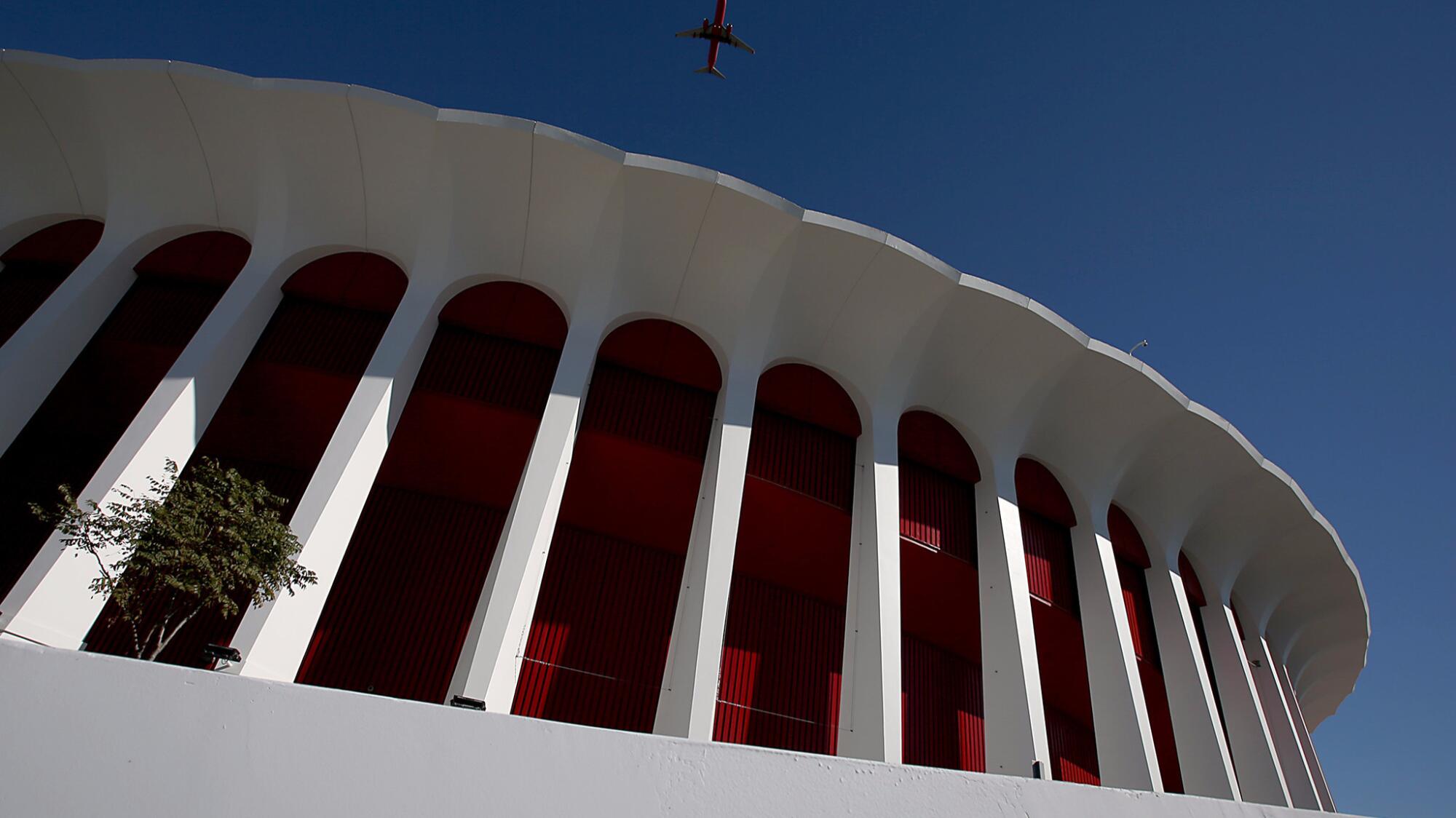
Maddox: So I’m looking at, what would I call it? I guess a red building, surrounded by columns that encircle it, almost like the colosseum vibes.
Brennan: It’s very funny that you mention the colosseum, because Carolina Miranda, an arts and urban design columnist at the L.A. Times, says that’s actually completely wrong.
Maddox: OK. That’s interesting. Why, what, what, what’s completely wrong about it?
Brennan: So I didn’t know this either.
Carolina Miranda: I would say the only way it’s inspired by the Colosseum is that it is also circular. But it does have these kind of Classical-style columns that cover the entire circular facade of this building, which I think mark this moment in Los Angeles in the 1960s. There was a lot of stuff like that that was being built during this era — this kind of Modernist reimagination of classical Roman architecture at this moment in which L.A. is kind of coming into itself.
Brennan: Because while we know the Forum as an emblem of the 1980s Lakers, it was actually built a couple decades earlier. Kareem, do you know anything about the history of L.A. before the 1960s?
Maddox: I’ve seen “L.A. Confidential.” I would say, like, surprisingly little.
Brennan: I don’t think you’re alone in that, and that is, in part, because L.A. really doesn’t even come into its own until after World War II. During the war, most of the American aerospace industry ends up establishing itself in Southern California. And that leads to a huge population boom, and the growth and expansion of the city itself, from what you’re talking about. Like that the sort of like Hollywood noir days of before the war totally becomes the L.A. that we know today, this sort of like sprawling, diverse, economically vibrant, hard-to-pin-down city.
Miranda: In 1960, Life magazine wrote this whole story about the development of L.A. finally coming into its own, becoming a real city, being a place where aerospace was, being a place where car design happened, you know, L.A. was this place where we thought about what came next, not about the past.
Brennan: And so by the time you get to the 1960s, you have the city that’s kind of in its adolescence or early adulthood, and it’s ready to be taken seriously.
::
Brennan: Welcome to “Binge Sesh.” This season, we’re diving into the stories behind HBO’s “Winning Time,” the saga of the Showtime-era L.A. Lakers. I’m Matt Brennan, L.A. Times TV editor and big old history nerd.
Maddox: And I’m Kareem Maddox, professional basketball player and native Angeleno. This week, we’re talking about the Forum, symbol of optimistic midcentury L.A. and home of the Showtime Lakers.
Brennan: What was most amazing to me about the conversation I had with Carolina Miranda is that the Forum’s architect also worked on the Los Angeles County Museum of Art and the airport all in the same period.
Miranda: Charles Luckman’s hand is in so much of Los Angeles. He helped design the civic center area in Inglewood, the Disneyland Hotel, CBS Television City. He was part of the team that worked on LAX.
Brennan: So Charles Luckman and other civic boosters want to build all these institutions like art museums and concert halls and stadiums in order to show off L.A. as this city of the future. Jerry Buss was, I think you could argue, attempting to do the same thing with the Lakers and the NBA in the 1980s that Charles Luckman and civic leaders were trying to do with the city as a whole starting in the 1960s.
Maddox: OK. And where does the Forum fit into this?
Brennan: I was just getting ready to explain that — right after the break.
::
Brennan: Welcome back to “Binge Sesh.” So, Kareem, the Forum was where team owner Jerry Buss focused his energy when it came to making the Lakers the entertainment product we’ve been talking about all season. There’s actually a great moment in Episode 4 of “Winning Time” where the character of Claire Rothman sort of explains the vision for the Forum.
[“Winning Time” clip: Claire Rothman character: Anyone can get a hot dog at concessions. We’ll have a nightclub more exclusive than Hugh Hefner’s grotto. Every team’s got fans. We’ll have celebrities sitting in the best seats in the house, a new row, right on the floor for all the cameras. Stars of the show.]
Maddox: Oh, the nightclub she’s talking about — that’s the Forum Club?
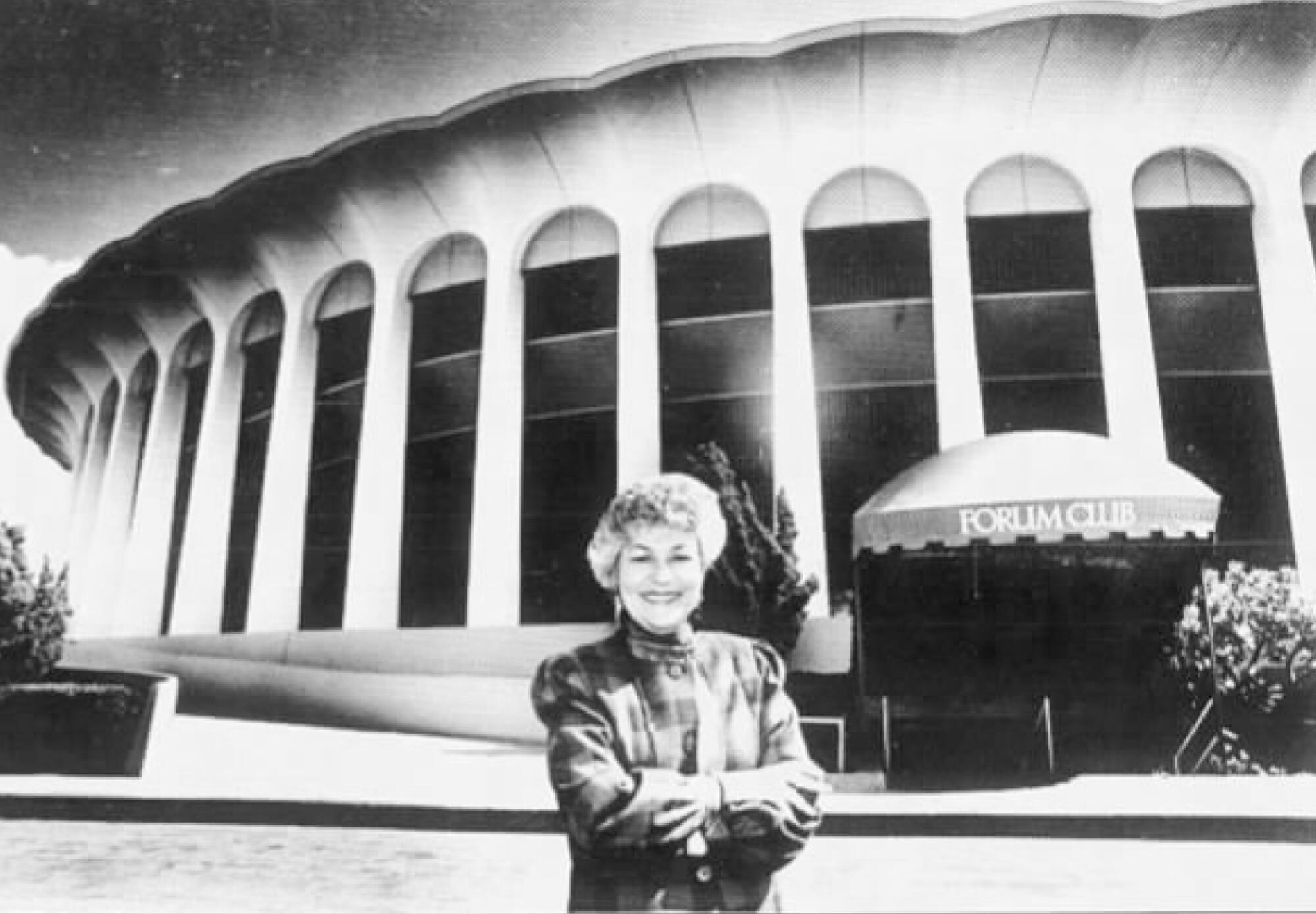
Brennan: Right. Let’s talk about the Forum Club. It’s part of the Forum building, built right in. Jeff Pearlman, who wrote the book that “Winning Time” is based on, told us about it.
Jeff Pearlman: So the Forum Club is genius in a lot of ways, especially for the time period, because there was nothing — it had been a restaurant under Jack Kent Cooke, and Jerry Buss buys it and they decided to make it a club. And it winds up becoming sort of a Studio 54-type club for L.A.
Maddox: Could you, just for people who don’t know, what is Studio 54?
Brennan: It’s a famous disco in New York. It was kind of like the center of New York’s disco scene in the late ’70s and early ’80s. All of the luminaries of that era went there, and it becomes this kind of a pop cultural touchstone too.
Maddox: Jerry Buss would be happy about a Studio 54 comparison for the Forum Club?
Brennan: Oh, for sure. Not only because I think that’s kind of like the energy that he was going for, but because he held court there.
Pearlman: There was a table that Jerry Buss had his spot at the head of the table where he would sit, and all around him would be dignitaries and famous people and politicians. And they had a great chef. They had great drinks. It was just his place, you know. And it became the place to be seen in L.A.
READ MORE >>> The Forum Club: The ultimate sports bar
Maddox: You know who was also seen in L.A. at the Forum, is the Laker Girls. One of the first modern dance squads in professional sports.
Brennan: Oh, right. Yeah. So Paula Abdul was its star and its head choreographer. And she actually parlayed that into a huge career, first as a pop star and then as a television personality.
READ MORE >>> Ex-Laker Girl Slam-Dunks: Paula Abdul scores with debut album
I actually think people of our generation might know her best as a judge on “American Idol.” In any case, there’s a great pair of scenes in Episode 5 of “Winning Time” that I think kind of says everything about how the Laker Girls were distinct from the courtside entertainment that had come before. Here’s a conversation between the Jerry Buss character and a choreographer who does not like his ideas.
[“Winning Time” clip: Jerry Buss character: It’s all stiff. I want freedom. I want sex. I want them to call in the Catholic League of Decency.
Choreographer: I think what you want is a striptease.]
Brennan: So this is the scene where we see the character of Paula Abdul, who’s in the background, give an indication of where she’s thinking the dancing is going, which is a much more modern hip-hop influenced style.
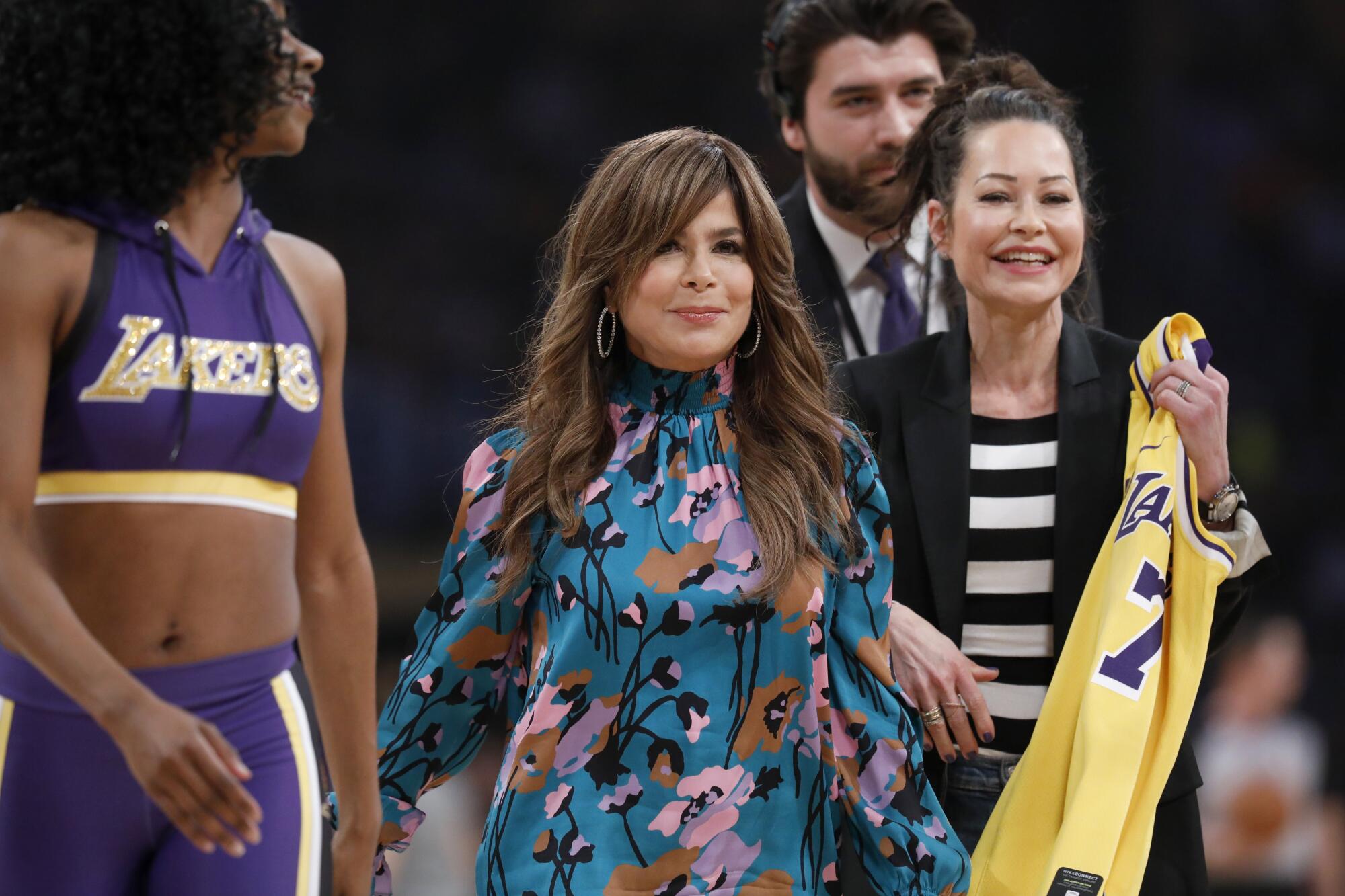
Then at the end of the same episode, Claire and Jeanie surprised Jerry at the opening of the Forum Club with a demonstration from the new, Paula Abdul-choreographed Laker Girls.
[“Winning Time” clip: Jerry Buss character: That ain’t ballet, I’ll tell you that. Now, that is a vision. That is female empowerment right there. Incredible. Claire, I can’t believe you pulled it off. We officially have a vision. Look at this. We really did it.]
Maddox: I do remember that line. That was very over the top.
Brennan: From your perspective as a basketball player, when you’re on the court, are you so in the zone that you don’t notice what’s going on around you? The cheerleaders and dance squads and mascots and marching bands?
Maddox: Me, personally, I see everything; it’s part of the experience of playing for me. But some guys claim to be totally locked in that they don’t see anything. But I think at the NBA level, it’s kind of hard as a player not to start looking around when you play 82 games a year.
Brennan: I wonder if that’s an explanation for why things like the Laker Girls and the Forum Club took off for fans. I mean, if you’re a season ticketholder, even watching this game-changing team, 41 home games is a lot of basketball to watch, to not have any other attractions or inducements to get you to brave the L.A. traffic. One of those attractions, both for fans at the Forum and for TV viewers, was the phenomenon of celebrities sitting courtside — another Showtime innovation. Kareem, who’s the celebrity you associate most with the Lakers?
Maddox: Here’s Johnny! Jack Nicholson for sure. Hands down.
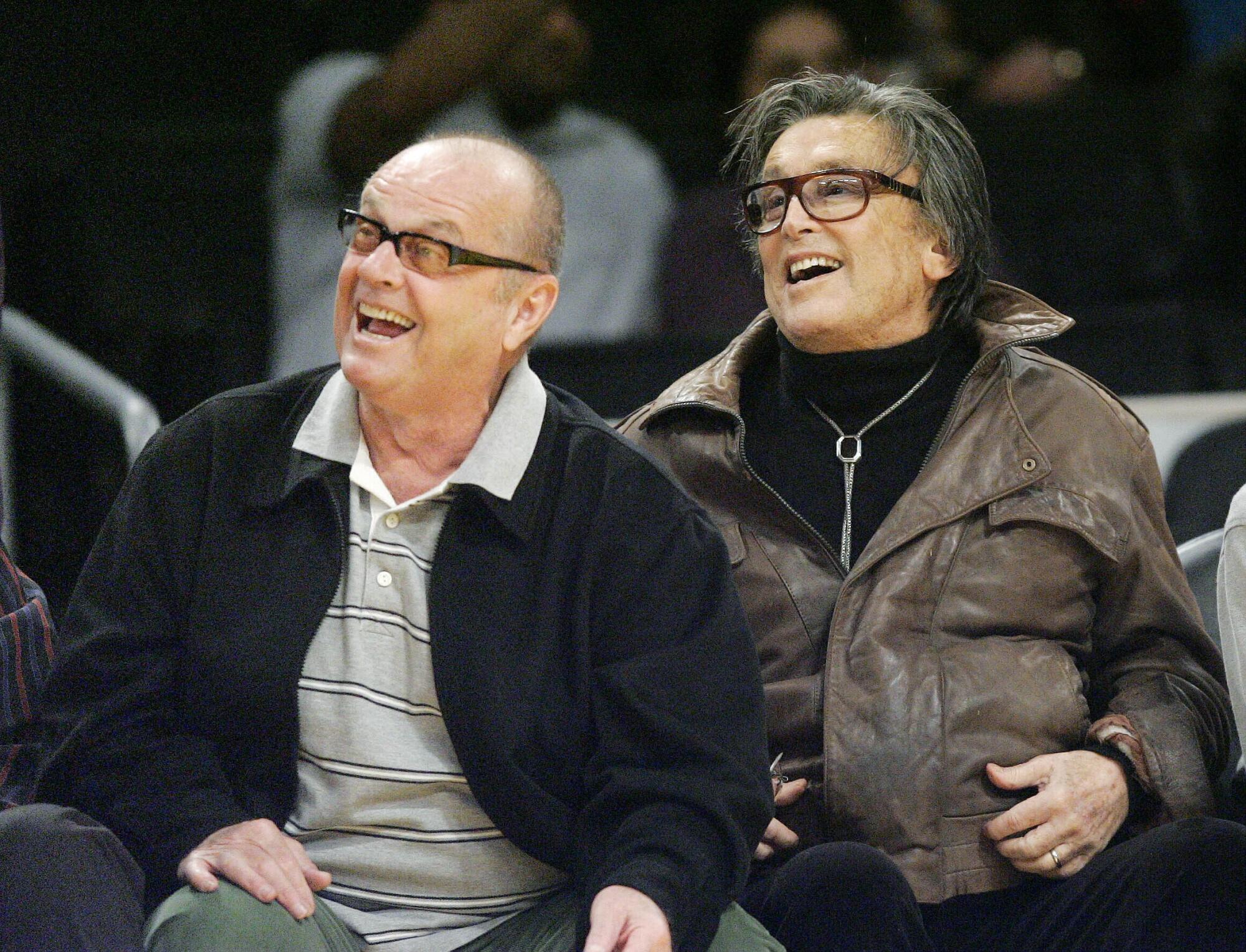
Brennan: There’s actually a great scene in Episode 6 of “Winning Time,” where Jack sends over a bottle of champagne to the Jerry Buss character and the Great Western guys while they’re having lunch at the Beverly Hills Hotel.
[“Winning Time” clip: Jerry Buss character: Well, well, well, what do we have here?
Waiter: It’s from the signore.
Jack Nicholson character: It’s on me, pal.
Jerry Buss character: Jack, you shouldn’t have.]
Brennan: I think that scene illustrates the kind of connection that Jerry and the team had with celebrity culture. It’s not just celebrities are fans of the team. It’s that the owner of the team and the players are celebrities themselves. And they’re hanging out at the same spots.
Maddox: Why does the Forum feel especially important for that?
Brennan: It creates a different feeling — like the theatrical lighting and the celebrities courtside and the nightclub upstairs and the dance troupe during timeouts — it creates a very different vibe than what you get at, say, the Boston Garden. DeVaughn Nixon, who plays his dad, Norm Nixon, in “Winning Time,” talked about this.
DeVaughn Nixon: The Forum just has this warmth and it just, it just makes you feel like it’s showtime, as cliche as that sounds, it really is. It really is with the Laker girls, the music playing behind it. And then when Magic came on the team, the flash, the pizzazz, all of that stuff. Just being on the show was so nostalgic for me because I grew up in that time period and my dad was a part of that team, so it really meant a lot.
Brennan: It’s also something that Max Borenstein, the showrunner and co-creator of “Winning Time,” talked about.
Max Borenstein: I think for me, particularly having grown up in the valley, having that sort of slightly outside-in view of the glitz and glamor of the Forum and of everything that Showtime kind of represented — I remember going to one game as a kid, because we couldn’t afford all that much more, and sitting in the rafters with my, in my memory, my head was touching the rafters. I’m sure it wasn’t exactly that, but I vividly remember that. And just kind of like the steamy smoky feel of that arena, which didn’t feel anything like Staples Center.
Brennan: Did you get to go to the Forum ever when you were growing up?
Maddox: I don’t think I’ve ever seen a Lakers basketball game at the Great Western Forum.
Brennan: Have you been to the Forum in other contexts? Like for a concert?
Maddox: I want to say I went to like an L.A. Sparks game there or something. Or maybe a concert.
Brennan: In an interview with the L.A. Times several years ago, when her memoir “Laker Girl” came out, Jeanie Buss actually talked about how important concerts were to the development of the Forum as an entertainment venue that went beyond basketball and hockey.
Jeanie Buss: My dad realized he’s got an arena, and you want, when you own and operate an arena, you want it booked 365 nights a year. And when you have a hockey team and a basketball team, with the playoffs and other things, maybe that’s 150, 180 events. There’s still a lot of time to fill. I was graduated from high school and it was the happiest day of my life because, as my dad put it, you know, name a concert, and now you can sit in the front row or maybe you can even sit on the stage, you know, just like what 17-year-old kid wouldn’t love that idea?
Maddox: Have you ever been to a concert at the Forum?
Brennan: No, actually, I haven’t. I don’t know why I was under the impression the Forum was empty. When I was in college at USC, Staples was already the center of gravity for all of the biggest events in L.A. The Forum, from the time that I was in college until really starting to do research for this episode, struck me more as a relic of the past than as a functional site, which is not true. But I think maybe that impression says something about where we are in terms of Forum history.
Maddox: I am very curious about the Forum because I feel like I see it when I fly in. I’ve never been for the thing — and will never be able to go for the thing that it’s known for, which is the Lakers. And it feels small. I would imagine by modern standards, it doesn’t seat a lot of people. It looks like a building — if I can speak freely, it looks like a building waiting to be torn down.
Brennan: The reason we got the Staples Center, now Crypto.com Arena, is because the NBA that Jerry Buss created outgrew the Forum. The Forum only has about 17,000 seats, and it doesn’t have the kind of luxury boxes that are so key to corporate ticket sales, which have become really important to pro sports economics. Showtime ended up propelling the NBA to these unheard of heights in terms of the money involved, star power involved, and the Forum becomes a symbol of that growth in the sense that it ends up being left behind. We’ll talk about what it was left behind for after the break.
::
Maddox: How did we get from the fabulous Forum to Crypto.com Arena?
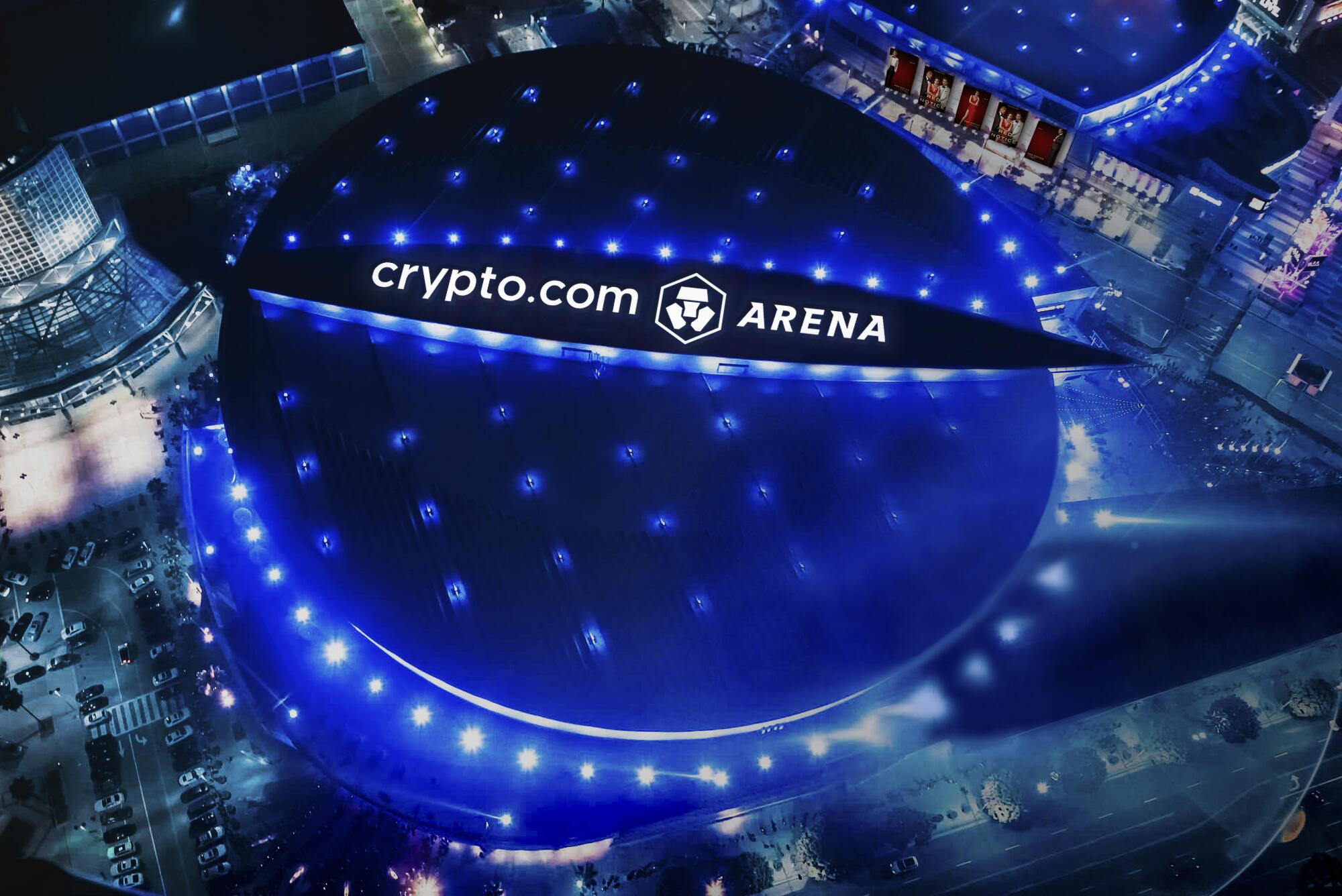
Brennan: I love that I could hear your eyes roll.
Maddox: Yeah.
Brennan: The Staples Center, which was renamed Crypto.com Arena on Christmas Day 2021, opens on October 17th, 1999.
READ MORE >>> Staples Center Bows as L.A.’s Newest Palace
That was the year of the last Lakers and Kings games at the forum. Carolina Miranda talked to me about the way that the new arena and L.A. Live, which is the entertainment venue adjacent to it, offer a very different vision of Los Angeles than the one that the Forum and the other buildings by Charles Luckman symbolized.
Miranda: I think that architecturally, it represents a massive shift. You know, if you think about the Forum, the Forum is a standalone building — in a sea of parking, but nonetheless, a standalone building. And in fact, for a long time, it was just the Los Angeles Forum and didn’t have any corporate sponsorship. The corporate sponsorship didn’t come in until way later, when for a time it was known as the Great Western Forum due to a sponsorship from Great Western Savings and Loan.
But I think Staples represents a real shift in that direction because as part of this L.A. Live complex, you are now not just a building, but you are an entire complex.
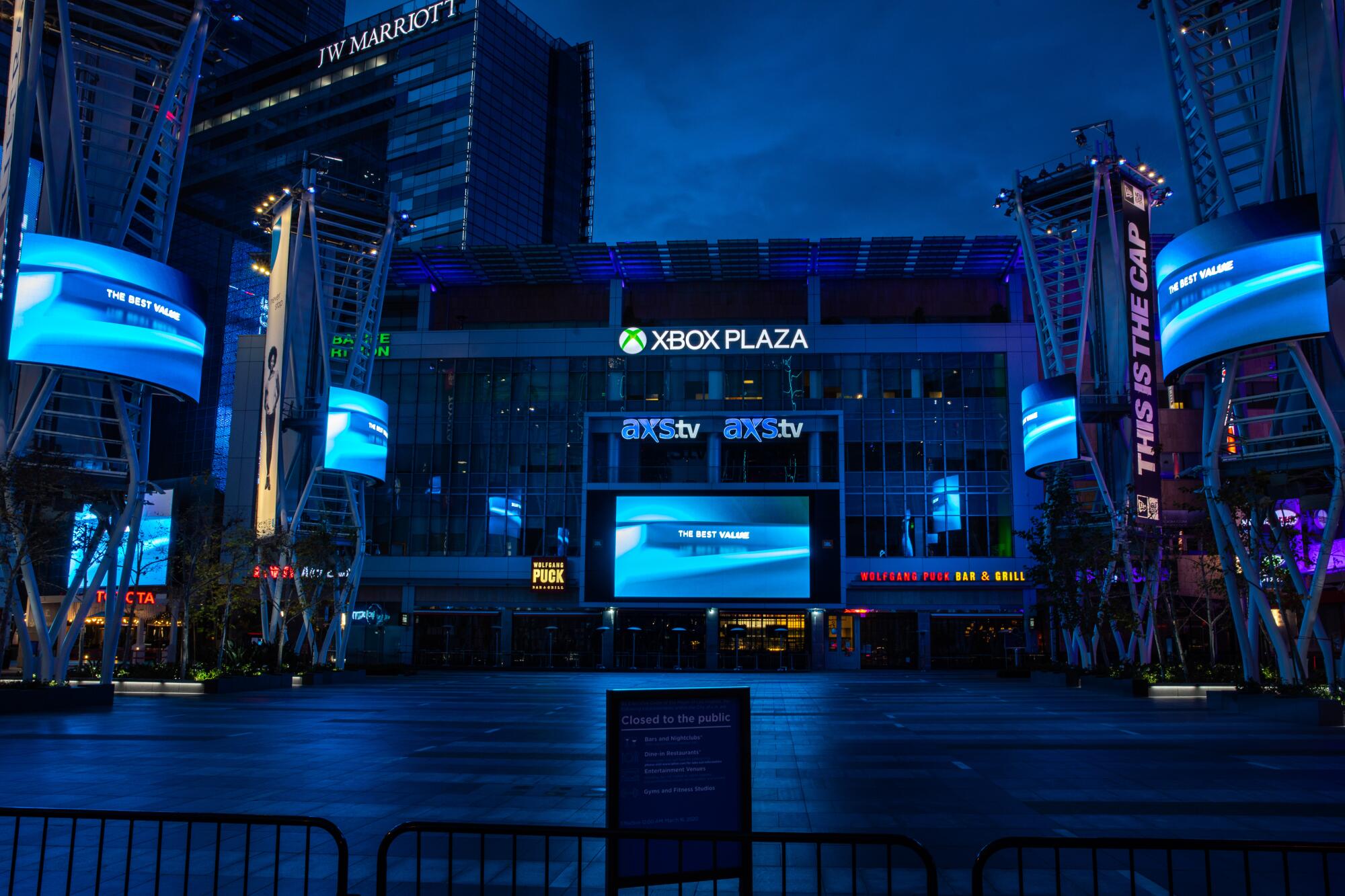
I mean, it is really creating an environment in which all of the quote unquote public space is private, you know, the plaza areas, the walkways, the pedestrian ways, all of that is controlled by corporations. And therefore, all of the images you see there are controlled by corporations. And it is this architecture that is very — that leans into that, that leans into its corporateness. And I think it does mark this real shift away from teams operating in venues that, you know, felt like a part of their communities to a degree. I mean, stadiums have always been problematic in a million other ways at the urban level, too. But it is quite a different experience.
Kareem: For Laker fans, I think there’s a stronger affiliation with the Forum than there is with Crypto.com Arena or what was Staples Center partially because of Showtime. I think that the Forum feels like the home of the Lakers. It’s this iconic building and it feels like the home gym, whereas I feel a little bit like the L.A. Live area and even, you know, Crypto.com Arena lose some of that for sure.
Brennan: I think that’s why the Forum continues to have its supporters. Even though the Lakers and the Kings haven’t played there since 1999, the Forum’s held church services, concerts, award shows. It’s held boxing and wrestling matches. It’s slated to host the gymnastics competition in the 2028 Olympics when they come to L.A. Carolina Miranda had a really great memory of a benefit concert that Prince threw at the Forum in 2011.
Miranda: Imagine me in an ocean of black and purple lace, screaming. People had kind of given up on the Forum. You know, the Lakers had been gone for over a decade. There were whispers about, you know, what do you do with this antiquated piece of sporting infrastructure? And Prince played a 21-night residency at the Forum to draw attention to the building’s plight. And the tickets cost 25 bucks. That is my favorite Forum memory. And then I think that is followed by being at a Kings game in the 1980s and seeing a lot of fist fights.
Brennan: I think Carolina’s memory of Prince at the Forum speaks to the same feeling of warmth that DeVaughn Nixon was talking about, or the same feeling of being part of this L.A. community that Max Borenstein was telling us about. The Forum has been around long enough for multiple generations of Angelenos to have formed really fond memories there. And I don’t care how much money you spend on a stadium. You can’t buy that.
Maddox: Absolutely not.
Brennan: What you can buy is an athlete’s endorsement, which is the subject of next week’s “Binge Sesh.” Good night!
::
Maddox: When I talk to my friend’s parents, Ron and Mary Weiss, they have all these awesome memories about the Forum. Can I play this for you here?
Matt: Sure.
Ron and Mary Weiss: And we’re at the forum and we’re walking, we’re in the basement, like the bowels of the Forum. Walking through little corridors and stuff. We’re like in the cement walls and we’re walking, walking, I’m thinking, “Oh my God, where in the hell are we going?”
And so all of a sudden they open a door. And it was this wood-paneled gorgeous room. Trophies everywhere. It was Jerry Buss’ private dining room that he would host — I mean, it was gorgeous. You could see all the wood and there were all trophies. And I mean, it was in the basement of the Forum.
Maddox: So these are big Laker fans. Yeah.
Matt: No, I mean, I think what you can hear in their voices is they’re still awestruck by it. And they would have had to be, they probably went to this dinner like 30 years ago.
Maddox: Oh yeah, exactly. There’s a photo of it. That’s that’s in their game room, which is right next to their TV room, is a photo of this dinner, which is Ron and Mary and the middle and all these, like people. The picture has been up there for 30 years. That’s a lasting impression that the Forum has made on these people’s lives.
Everything you need to know about the true story of the Showtime Lakers, all in one place.
Additional resources
Charles Luckman, “Twice in a Lifetime: From Soaps to Skyscrapers” (1988)
Jeff Pearlman, “Showtime: Magic, Kareem, Riley, and the Los Angeles Lakers Dynasty of the 1980s” (2013)
Wim de Wit and Christopher James Alexander, eds., “Overdrive: L.A. Constructs the Future, 1940-1990” (2013)
More to Read
The complete guide to home viewing
Get Screen Gab for everything about the TV shows and streaming movies everyone’s talking about.
You may occasionally receive promotional content from the Los Angeles Times.

